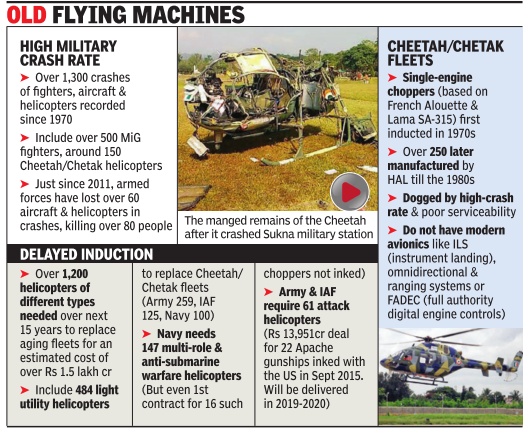Helicopters (defence forces): India
This is a collection of newspaper articles selected for the excellence of their content. |
Helicopter Fleets in the Indian Defence Forces

Cheetah helicopters
Status of fleet in 2016
Rajat Pandit: Dec 1, 2016: The Times of India

Aging, obsolete chopper fleets take toll on military
Old and obsolete machines, whether they be fighters or helicopters, continue to exact a heavy toll in the armed forces. Three Army officers were killed and a soldier critically injured when their Cheetah helicopter crashed at Sukna military station in West Bengal on Wednesday , in yet another grim reminder of the military's ageing light utility helicopter fleets.
The Cheetah, being flown by Majors Sanjeev Lathar and Arvind Bazala, was about to land after a reconnaissance mission in forward areas when it crashed at 11.45 am.Lt-Colonel Rajneesh Kumar, posted in the operations wing of 33 Corps, was also killed in the crash, while sapper Dhamne Yogesh Bhaskar is in a critical condition at Bengdubi military hospital.
Incidentally , another Cheetah helicopter, which landed just before the ill-fated one, had the chief of staff of 33 Corps, Major General Vikal Shahni, on board. “There was a sudden technical snag in the chopper that crashed. It could be engine failure or tail-rotor cable rupture,“ said an officer.
Though the court of inqui ry will establish the exact cause, the crash once again underlines that the armed forces are being forced to fly old single-engine Cheetahs in the absence of modern twin-engine choppers. Failure of successive governments to take timely decisions, shoddy performance of defence PSU Hindustan Aeronautics (HAL) and recurring corruption scandals have all combined to lead to this abysmal situation.
CheetahChetak light utility helicopters, in fact, are now increasingly being dubbed the “MiGs of the chopper fleets“ due to their high crash rates and poor serviceability .In March last year, a group of wives of Army officers had even petitioned defence minister Manohar Parrikar to stop the use of these “outdated“ helicopters to avoid casualties.
Based on the 1960s' technologies, Cheetahs are bereft of modern avionics like ILS (instrument landing), omnidirectional and ranging systems or FADEC (full authority digital engine controls). “Over 50% of choppers in Army aviation fleet are well over 30 years old.Moreover, it has just 70% of its authorised helicopter strength, which includes around 140 Cheetahs, 50 Chetaks and 80 Dhruv advanced light helicopters,“ said an officer.
After the procurement of 197 new light utility helicopters from aboard was scrapped three times over the last decade due to technical deviations and corruption allegations, the NDA government in August 2014 decided they would be “Made in India“ with foreign collaboration.
But the much-touted joint venture with Russia for 200 Kamov-226T light utility helicopters for around $1 billion is yet to kick off. While the first 60 choppers will come from Russia, the rest are to be produced in India over nine years.
In a double whammy , HAL is also far away from delivering 187 light helicopters it was supposed to make “within 60 months“ when another project was sanctioned by the Cabinet Committee on Security in February 2009.